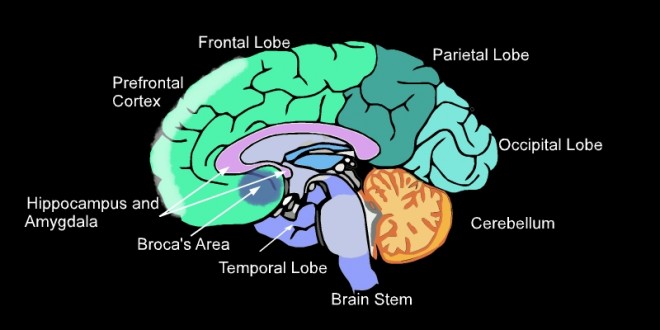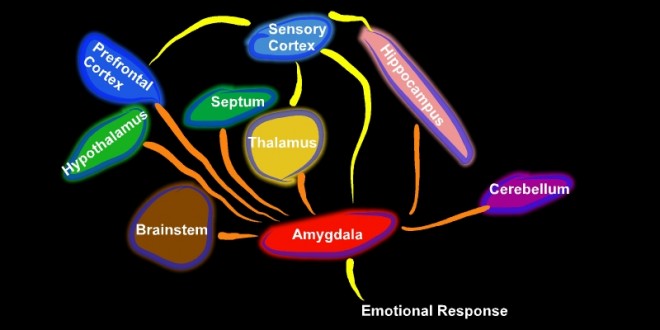Executive Function (EF) is a term that describes the way that specific mental processes regulate other cognitive emotional and behavioural functions and actions. It is something of an umbrella term and covers more specific aspects such as Local Coherence, Empathy and Emotions, each of which have their own sections in this document.
Executive Function is such a large area of brain function that it is valuable to look at some of the physical and neurological aspects involved. There has been much research over the past decade using Functional Magnetic Resonance Imaging (fMRI) to examine the activity in various brain structures under the influence of sensory and memory stimuli. These studies have shown, not only the regions of the brain involved in particular activities, but the pathways between them and the time taken for impulses to travel.
- The diagram below indicates some of the major structures.
- Prefrontal Cortex - logical thought
- Hippocampus - explicit conscious memory, learning
- Hypothalamus - relays olfactory data, generates many hormones for instantaneous and long term body function, homeostasis and emotion regulation
- Septum - pleasure areas, balancing fear pathways
- Brainstem - attention, arousal, consciousness, heart and breathing
- Cerebellum - motor function, rhythm
- Broca's Area - speech production
- Parietal Lobe - contains the sensory cortex for sensory perception and integration
- Occipital Lobe - visual perception
- Temporal Lobe - memory, organising sensory input
(Brain Injury Law Group, 2002; Canadian Institute of neurosciences, mental health and addiction, 2003; Goleman, 2005; Zatorre & Krumhansl, 2002)
Within the so-called limbic system, the amygdala is actually a pair of almond shaped bodies on the ends of the hippocampus, which in a sense are the "heart" of the brain, as they are largely responsible for our emotional responses. Current understanding is that the connections to the amygdala from the sensory inputs create "emotional memory". This includes experiences from very early, preverbal, childhood and experiences that are non-lingual, but have a strong emotive context, such as fear or strong bonding. In most circumstances the emotional reactions are regulated by thought via a pathway to the emotion centre from the "thinking" sections of the brain in the neocortex, however there is also a much shorter pathway directly from the sensory input centre in the thalamus. In "emergencies" this shorter pathway allows extremely fast responses to a large amount of information. This short pathway is the apparent mode by which "instinctive" or immediate reactions to sudden appearance of danger can occur before the thinking brain has time to process. I once lifted the lid of my compost bin and found a king brown snake inside - one of Australia's less cuddly garden visitors. As it struck I knocked it sideways with my one hand and replaced the lid with the other. The whole event occurred in a fraction of a second - there was certainly no time to think, and my cognitive memory is a single image, like a photograph, that enables me to identify the snake.
In addition to the general notes about brain structure, and their functions in cognition and emotion, it is useful to look at some of the brain functions associated with music. Levitin notes that certain parts of the amygdala that process the emotive content of instrumental music are also used for processing the non-verbal elements of spoken language (Levitin, 2006, pp. 84-86; Zatorre & Krumhansl, 2002). This is the so-called "paralanguage" including tone and prosody (rhythm, accent and intonation) that carry emotive context and help identify irony and sarcasm and define the difference between a question and a statement. The secondary route for these aspects of language is in the right cerebral hemisphere, along with the processing areas for melodic contour. Research in to the way that music enhances affective perception in films used fMRI to map brain activity in the frontal cortex and amygdala, indicating that "emotional pictures evoke a more cognitive mode of emotion perception, whereas congruent presentations of emotional visual and musical stimuli rather automatically evoke strong emotional feelings and experiences" (Baumgartner, Lutz, Schmidt & Jaencke, 2006, p. 164). In addition Koelsh, (2006) found that "pleasant" (consonant) music is processed more in the frontal language areas of the brain, while "unpleasant" (constantly dissonant) music is more strongly processed in the emotive right amygdala, associated with fear and negative emotions.
The diagram below indicates some of the major pathways to the amygdala, the emotional "centre" of the brain. Each of the various structures has specific functions, some of which are indicated here. Input from the senses is received by the thalamus, in the very middle of the brain, and is distributed to the Cognitive (cerebral) and emotive (limbic) systems. Note that the thalamus has both a direct connection to the Amygdala and a slower route via the Prefrontal Cortex.
In terms of day to day functioning, the pathways between the limbic (emotions, emotional memory) and cerebral (cognitive) aspects of the brain are vital in maintaining the cognitive / emotional, thought / feeling, head / heart balance. The regulation of these neural pathways appears to be one of the principle modes of operation of Executive Function (Attwood, 2008, p. 145). In ASD individuals, studies have shown that there are some distinct differences, both in size of the amygdala (Dziobek, Fleck, Rogers, Wolf & Convit, 2006; Munson et al., 2006) and in the ways that activity and connectivity between limbic and cognitive systems (Ashwin, Baron-Cohen, Wheelwright, O' Riordan & Bullmore, 2007; Haznedar et al., 2000; Kleinhans et al., 2008) occur. In the studies cited, which looked at both structural elements and active function, the correlation between "abnormal" physiology and function and depth of ASD symptomology was noted. For many individuals with weak Executive Function the emotional connections are impaired, which can result in difficulties recognising and describing their own emotions, a conditional called alexithymia, literally, no words for the feelings.
Given the strong correlations between music perception and emotional regulation, it should not be surprising to note that many autistic people, myself included, have differing emotional relationships to with music to the "typical" person. In short, many autistics enjoy music for its sound and structure, but are not necessarily moved by it (Sacks, 2008, p. 290). A primary discovery within this research has been of my own emotional ambivalence to hearing music as opposed to making music, and this is explored in detail in later a later section of this document devoted to Emotion Regulation.
Related Posts
- Music for the Mind: Music has long been known to improve some aspects of functioning over time.
- Theory of Mind: Theory of Mind is a term that describes the spontaneous abilty to adopt the point of view of another person.
- What is Executive Function?: Executive Function is the primary controller of cognitive behaviour.
- Insights: This section is titled Insights because I believe that more traditional terms such as "findings", "data" or "discussion" are inadequate.
- Faces and Bits: Prosopagnosia, or face-blindness, can affect both recognition of people and their nonverbal language.
- The Safer Intimacy: Some forms of intimate communication are "safer" than others and facilitate a greater degree of emotional freedom.
- Can you feel it?: On realising that perhaps my subjective experience of music was different to those around me, I panicked ...

